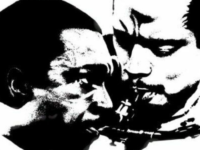It’s perhaps no surprise that John Coltrane wanted to do something different upon moving to the Impulse label after a long association with Atlantic. No surprise, either, that it might be a recording with a larger aggregate behind him. That was, and is, the style of the day when jazzers seek to get out of the box a bit.
Leave it to John Coltrane to turn all of that on its ear with Africa/Brass, a 1961 release that – because of its orchestration – is at once rumbling and mellow, rather than swinging and bright. Coltrane hand picked a back-up group that featured only trumpets, trombones, French horns, tuba and euphoniums (a rarely used baritone horn).
Pianist McCoy Tyner, who even then had such burnished layering in his block-style approach, led Coltrane to this place. And it marked the beginning of a period of deep introspection and startling experimentation over the six years that remained before Coltrane’s tragic, too-soon passing.
John Coltrane’s only Impulse recording with legendary producer Creed Taylor, Africa/Brass actually includes, in all but one tune, charts by future Coltrane regular Eric Dolphy — who listened intently to Tyner, and matched his texture and style. These music sheets were created from rough sketches by Coltrane, and workshopped right in the studio.
In this way, Coltrane kept the basic quartet approach, despite having all those other guys in the room. The close-knit, absorbing Africa/Brass, interestingly, had a limited number of solo voices — despite an orchestra that included Dolphy, Booker Little, Paul Chambers, Julian Priester and Freddie Hubbard, among others. It remained immediately identifiable as Coltrane, even in the new setting.
We hear an expected, by then, take on a waltz standard in “Greensleeves” — something few would question after the artistic and commercial successes of John Coltrane’s blockbuster “My Favorite Things” in 1960. The difference is drummer Elvin Jones, who was becoming ever more confident in the polyrhythms that would dominate jazz in the decade to come.
More interesting was the chant-like, almost religious beauty of “Africa,” this set’s centerpiece — and the launching pad for Coltrane’s move away from swing conventions into drones as a compositional foundation. Likewise, “Blues Minor,” worked out on the spot by Dolphy in a style that fit well with the stirring creativity now associated with this group, broods and swings with equal power.
Just that quickly, John Coltrane reinvented the one-off, large-group project. Rather than sounding like a patch job, as many of these things so often do, the attention to improvisational detail, and careful selection of instrumentation, instead make “Africa/Brass” dark and powerful — adding unexpected hues to one of jazz music’s most brilliant improvisers.
Unfortunately, this is one of only two big-band sessions by Coltrane (the other being the otherworldly Ascension, also on Impulse, from 1965). Yet, Africa/Brass somehow — and this is baffling — remains one of his lesser talked-about releases. To my mind, though, no John Coltrane collection is complete without it. Even decades later, Africa/Brass still casts him — and this is saying something — in a new, insistently inventive light.
- How Deep Cuts on ‘Music From Big Pink’ Underscore the Band’s Triumph - July 31, 2023
- How ‘Islands’ Signaled the Sad End of the Band’s Five-Man Edition - March 15, 2022
- The Band’s ‘Christmas Must Be Tonight’ Remains an Unjustly Overlooked Holiday Classic - December 25, 2016



